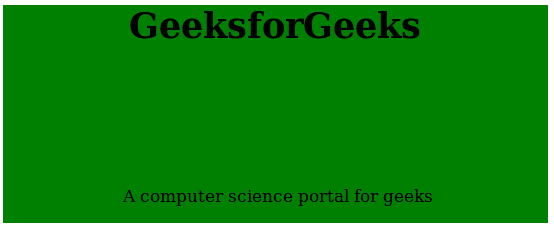How to position a div at the bottom of its container using CSS?
Last Updated :
29 Jan, 2024
To position a div at the bottom of its container in CSS, you can use various approaches. Using absolute positioning involves setting `position: absolute;` and `bottom: 0;`, aligning the div at the container’s bottom. Flexbox achieves this by employing `display: flex;` and `margin-top: auto;`, while Grid utilizes `display: grid;` with a defined template that reserves space at the bottom for the targeted div.
Using Absolute Positioning:
This approach uses position: absolute; bottom: 0; to place the div at the bottom relative to its closest positioned ancestor.
Example 1: This example shows the positioning of a div at the bottom of its container using absolute positioning.
html
<!DOCTYPE html>
<html>
<head>
<title>Position a div at bottom</title>
<style>
.main_div {
text-align:center;
position: relative;
left: 100px;
height: 200px;
width: 500px;
background-color: green;
}
.sub_div {
position: absolute;
bottom: 0px;
}
p {
margin-left:110px;
}
</style>
</head>
<body>
<div class="main_div">
<h1>GeeksforGeeks</h1>
<div class="sub_div">
<p>A computer science portal for geeks</p>
</div>
</div>
</body>
</html>
|
Output: 
Using Flexbox
This approach utilizes display: flex; and margin-top: auto; to push the div to the bottom within a flex container.
Example 2: This example shows the positioning of a div at the bottom of its container using flexbox.
html
<!DOCTYPE html>
<html>
<head>
<title>Position a div at bottom</title>
<style>
.container {
display: flex;
flex-direction: column;
align-items: center;
justify-content: space-between;
min-height: 200px;
width: 500px;
background-color: green;
margin-left: 100px;
}
.bottom-div {
margin-top: auto;
}
p {
margin-left: 50px;
}
</style>
</head>
<body>
<div class="container">
<h1>GeeksforGeeks</h1>
<div class="bottom-div">
<p>A computer science portal for geeks</p>
</div>
</div>
</body>
</html>
|
Output:

Using Grid
It uses display: grid; and grid-template-rows: 1fr auto; to create a grid layout with flexible and fixed-sized rows, positioning the div at the bottom.
Example 3: This example shows the positioning of a div at the bottom of its container using grid.
HTML
<!DOCTYPE html>
<html>
<head>
<title>Position a div at bottom</title>
<style>
.container {
display: grid;
grid-template-rows: 1fr auto;
min-height: 200px;
width: 500px;
background-color: green;
margin-left: 100px;
}
h1 {
text-align: center;
}
p {
margin-left: 140px;
}
</style>
</head>
<body>
<div class="container">
<h1>GeeksforGeeks</h1>
<div class="bottom-div">
<p>A computer science portal for geeks</p>
</div>
</div>
</body>
</html>
|
Output:

CSS is the foundation of webpages, and is used for webpage development by styling websites and web apps. You can learn CSS from the ground up by following this CSS Tutorial and CSS Examples.
Like Article
Suggest improvement
Share your thoughts in the comments
Please Login to comment...